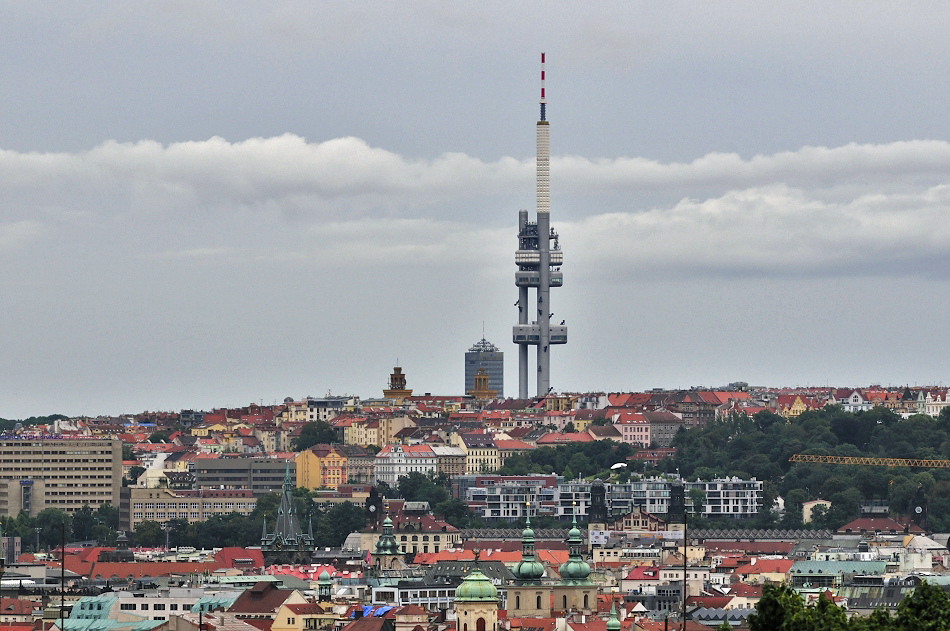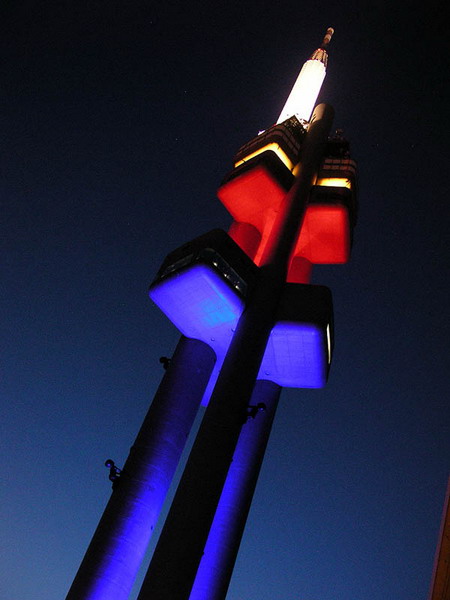The Žižkov Television Tower (Czech: Žižkovský vysílač) is a unique transmitter tower built in Prague between 1985 and 1992. Designed by the architect Václav Aulický and the structural engineer Jiří Kozák, it stands high above the city's traditional skyline from its position on top of a hill in the district of Žižkov, from which it takes its name. The tower is an example of high-tech architecture.
The structure of the tower is unconventional, based on a triangle whose corners are growing up in steel columns, consisting of three tubes with a double steel wall, filled with concrete. They support nine 'pods' and three decks for transmitting equipment. One of the three pillars extends considerably higher than the others, and this provides both the necessary height for some antennas, along with the structure's rocket and gantry appearance. In its time it was a unique technology, which authors have patented. In total, the tower stands 216 metres (709 feet) high.
Three of the pods, positioned directly beneath the decks at the top of the tower, are used for equipment related to the tower's primary function and are inaccessible to the public. The remaining six pods are open to visitors, the highest of which are observation rooms at 100 metres (328 feet), providing a panoramic view of Prague and the surrounding area. The lower three, approximately half-way up the length of the pillars at 63 metres (207 feet), house a recently refurbished restaurant and café bar. Elevators, equipped with speedometers, transport passengers to the different levels at a rate of 4 m/s. The tower weighs 11,800 tons and is also used as a meteorological observatory. It is a member of the World Federation of Great Towers.
Like many examples of communist-era architecture in Central and Eastern Europe, the TV tower used to be generally resented by the local inhabitants. It also received a spate of nicknames, mostly alluding to its rocket-like shape, e.g. "Baikonur" after Soviet cosmodrome, "Pershing" after the US IRBM, some more political, like "Jakešův prst" (Jakeš's finger, after the Secretary General of the Czechoslovak Communist Party), etc. Although official criticism during the time of its construction was impossible, unofficially the tower was lambasted for its 'megalomania', its 'jarring' effect on the Prague skyline, and for destroying part of a centuries-old Jewish cemetery situated near the tower's foundations. However, the official line remains that the cemetery was moved some time before the tower was conceived. Recently, the tower's reputation among Czechs has improved.
Rumours have also circulated that the tower was planned to be used to jam incoming western radio and television transmissions (particularly Radio Free Europe) and that it had a potential use as a communications facility for Warsaw Pact forces in the event of an attack on (or attack by) NATO.
Today, the tower attract visitors focusing on the tower's technological innovations and great view over city skyline.











